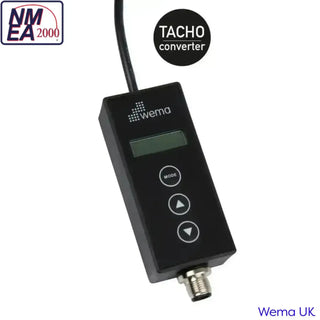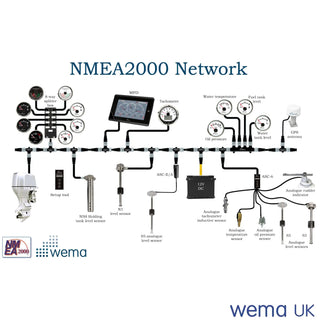NMEA2000 - 6 Channel Analogue to Digital Signal Convertor
- Unit price
- / per
• Tachometer (one dedicated channel)
• Fuel tank (compatible with 0-190, 10-180, 240-30 ohm ranges or user-defined)
• Water tank (compatible with 0-190, 10-180, 240-30 ohm ranges or user-defined)
• Holding tank (compatible with 0-190, 10-180, 240-30 ohm ranges or user-defined)
• Engine temperature (0-120°C range)
• Oil temperature (0-150°C range)
• Oil pressure (0-5 and 0-10 bar ranges)
• Turbo pressure (0-2 bar range)
• Rudder angle
• Trim angle
Description
The NMEA2000 - 6 Channel Analogue to Digital Signal Convertor is a versatile device designed for seamless integration with all Wema resistance sensors. This advanced digital signal convertor bridges the gap between analog and digital systems, enhancing the capabilities of marine electronics.
The innovative ASC-6 model features six analogue inputs, including five programmable channels and one dedicated tachometer channel. This configuration offers exceptional flexibility for various marine applications, allowing users to monitor multiple sensors simultaneously.
Functioning as an analogue-digital convertor, this device connects between an analogue sender and a NMEA2000 backbone. It efficiently converts analogue signals into NMEA2000 signals, ensuring compatibility with modern marine networking systems. This conversion process enables seamless integration of traditional analogue sensors into contemporary digital networks.
For customer convenience, we pre-configure the tank type and instance number for each channel before shipping. Customers can select their preferred options before adding the product to their cart. To purchase multiple converters, please add them to the cart one at a time to ensure accurate configuration.
The tank type setting identifies the specific tank on the NMEA network, while the instance number denotes the number of the same type of tank. For example, a single fuel tank should have an instance of 0. In cases with multiple fuel tanks, the port tank would be set to instance 0, and the starboard tank to instance 1. This numbering system applies to all sensor types and helps identify each sensor's location within the NMEA network.
For users who prefer to customize their settings, the converter features buttons that allow manual adjustment of the type and instance settings.
Learn more about NMEA2000
The ASC-6 channel analogue-digital convertor supports connection of up to six analogue sensors with the following functions:
• Tachometer (one dedicated channel)
• Fuel tank (compatible with 0-190, 10-180, 240-30 ohm ranges or user-defined)
• Water tank (compatible with 0-190, 10-180, 240-30 ohm ranges or user-defined)
• Holding tank (compatible with 0-190, 10-180, 240-30 ohm ranges or user-defined)
• Engine temperature (0-120°C range)
• Oil temperature (0-150°C range)
• Oil pressure (0-5 and 0-10 bar ranges)
• Turbo pressure (0-2 bar range)
• Rudder angle
• Trim angle
This comprehensive range of supported sensor types ensures that the ASC-6 can meet the diverse needs of various marine applications. Whether monitoring engine performance, tank levels, or vessel orientation, this versatile digital signal convertor provides accurate and reliable data conversion for seamless integration with NMEA2000 networks.
NMEA2000 - 6 Channel Analogue to Digital Signal Convertor
- Unit price
- / per
CHANNEL 1
CHANNEL 2
CHANNEL 3
CHANNEL 4
CHANNEL 5
CHANNEL 6
Your details are protected and safe with us.
The choice of shipping options is calculated at the checkout.
The price and available shipping options will depend on your location as well as the size and weight of your order.
If you choose 'free delivery' or some Royal Mail services, the order may not be trackable for the duration of the journey and only show tracking events when the order is shipped and when it is delivered.
We aim to dispatch all morning (GMT) orders the same day and all orders received afternoon or at weekends the following business day.
Once your order has shipped you will be notified by email.
Adding product to your cart
You may also like
• Tachometer (one dedicated channel)
• Fuel tank (compatible with 0-190, 10-180, 240-30 ohm ranges or user-defined)
• Water tank (compatible with 0-190, 10-180, 240-30 ohm ranges or user-defined)
• Holding tank (compatible with 0-190, 10-180, 240-30 ohm ranges or user-defined)
• Engine temperature (0-120°C range)
• Oil temperature (0-150°C range)
• Oil pressure (0-5 and 0-10 bar ranges)
• Turbo pressure (0-2 bar range)
• Rudder angle
• Trim angle
Description
The NMEA2000 - 6 Channel Analogue to Digital Signal Convertor is a versatile device designed for seamless integration with all Wema resistance sensors. This advanced digital signal convertor bridges the gap between analog and digital systems, enhancing the capabilities of marine electronics.
The innovative ASC-6 model features six analogue inputs, including five programmable channels and one dedicated tachometer channel. This configuration offers exceptional flexibility for various marine applications, allowing users to monitor multiple sensors simultaneously.
Functioning as an analogue-digital convertor, this device connects between an analogue sender and a NMEA2000 backbone. It efficiently converts analogue signals into NMEA2000 signals, ensuring compatibility with modern marine networking systems. This conversion process enables seamless integration of traditional analogue sensors into contemporary digital networks.
For customer convenience, we pre-configure the tank type and instance number for each channel before shipping. Customers can select their preferred options before adding the product to their cart. To purchase multiple converters, please add them to the cart one at a time to ensure accurate configuration.
The tank type setting identifies the specific tank on the NMEA network, while the instance number denotes the number of the same type of tank. For example, a single fuel tank should have an instance of 0. In cases with multiple fuel tanks, the port tank would be set to instance 0, and the starboard tank to instance 1. This numbering system applies to all sensor types and helps identify each sensor's location within the NMEA network.
For users who prefer to customize their settings, the converter features buttons that allow manual adjustment of the type and instance settings.
Learn more about NMEA2000
The ASC-6 channel analogue-digital convertor supports connection of up to six analogue sensors with the following functions:
• Tachometer (one dedicated channel)
• Fuel tank (compatible with 0-190, 10-180, 240-30 ohm ranges or user-defined)
• Water tank (compatible with 0-190, 10-180, 240-30 ohm ranges or user-defined)
• Holding tank (compatible with 0-190, 10-180, 240-30 ohm ranges or user-defined)
• Engine temperature (0-120°C range)
• Oil temperature (0-150°C range)
• Oil pressure (0-5 and 0-10 bar ranges)
• Turbo pressure (0-2 bar range)
• Rudder angle
• Trim angle
This comprehensive range of supported sensor types ensures that the ASC-6 can meet the diverse needs of various marine applications. Whether monitoring engine performance, tank levels, or vessel orientation, this versatile digital signal convertor provides accurate and reliable data conversion for seamless integration with NMEA2000 networks.


